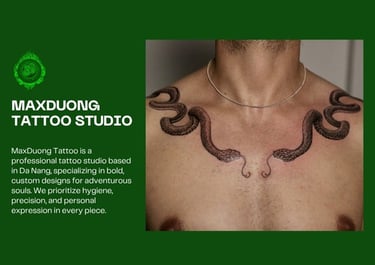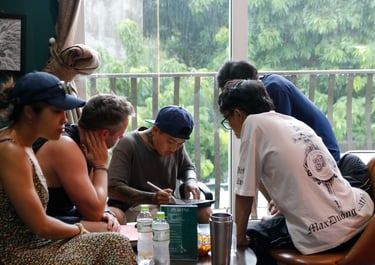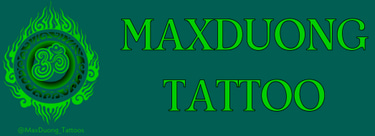Does Getting a Tattoo Hurt? A–Z Guide for First-Timers
Does getting a tattoo hurt? MaxDuong Tattoo shares expert tips on pain levels, least painful areas, pain relief methods, and tattooing process for beginners.
Adam D
6/23/20255 min read


"Does it hurt?"—that's the first question 95% of first-time visitors ask when they step into MaxDuong Tattoo Studio. With nearly a decade of experience, we understand this concern deeply, especially for those just starting their tattoo journey.
In this article, MaxDuong Tattoo will break down everything you need to know about tattoo pain—based on thousands of real-life experiences from our international clients. We'll also share lesser-known pain-reduction tips that actually work.
Why Do Tattoos Hurt? A Scientific Perspective
Tattooing involves injecting pigment into the dermis, the layer of skin located 1–2 mm below the surface, using specialized needles. Here's what happens:
Tattoo needles move at 50–3000 times per minute, creating thousands of micro-punctures.
These needles:
Pierce through the epidermis (which lacks nerve endings),
Reach the dermis, rich in sensory nerves,
Trigger pain receptors (nociceptors),
And send pain signals to the brain via the nervous system.
According to our research at MaxDuong Tattoo, the level of pain varies depending on:
The concentration of nerve endings in the tattooed area
The thickness of the subcutaneous fat layer
Bone and cartilage density nearby
Skin tightness
The artist’s technique and experience
Tattoo Pain Levels: What to Expect
Based on a pain scale of 1–10, here's what our clients typically report:
Low Pain (2–4/10):
Upper arm
Outer arm
Calf
Shoulder / Upper back
Moderate Pain (5–6/10):
Wrist
Inner forearm
Chest
Abdomen
High Pain (7–9/10):
Ribs
Spine
Groin
Hands & Feet


What Affects Tattoo Pain?
Tattoo Placement
Least Painful Areas – Great for Beginners:
Upper Arm: Thick muscle, fewer nerves, works for both small and large designs. Chosen by 80% of our first-timers.
Outer Arm: Less sensitive, minimal movement interference—highly recommended for male clients.
Shoulder: Wide surface, mild pain—ideal for complex tattoos. 90% of clients complete 3–4 hour sessions here without breaks.
Moderate Pain – Be Mentally Prepared:
Wrist & Inner Forearm: Popular but more painful due to thin skin and nearby bones. We recommend starting with smaller pieces.
Chest: Pain increases near the sternum. A skilled artist can reduce session time here significantly.
High Pain – For the Experienced Only:
Ribs: Among the most painful spots. We usually only tattoo here if the client already has 2–3 tattoos.
Spine: Very sensitive and risky without an experienced artist. A thorough consultation is essential.
Tattoo Size & Complexity
Small Tattoos (<5cm): 30–60 mins, minimal discomfort—perfect for beginners.
Medium Tattoos (5–15cm): Takes 1–3 hours, requires more mental prep.
Large Tattoos (>15cm): Typically divided into multiple sessions to prevent exhaustion.
Tattoo Style
Line Work: Least painful, beginner-friendly.
Shading: Moderate pain, takes longer to complete.
Color Fill: Most painful due to multiple ink layers and longer sessions. However, our advanced machines help ease this process.
Personal Factors
Pain tolerance varies by:
Age (younger people tend to tolerate pain better)
Gender (studies show women have 15–20% higher pain thresholds)General health
Tattoo experience
Mental state: stress and anxiety can increase perceived pain by 30–40%.


Pain Relief Tips from MaxDuong Tattoo Experts
Before Your Tattoo Session
Physical Preparation:
Get 7–8 hours of sleep the night before.
Eat a full meal 1–2 hours before your appointment to avoid dizziness or low blood sugar.
Stay hydrated (at least 2L/day for 2–3 days beforehand) to keep your skin supple.
Avoid alcohol for at least 24 hours—it thins the blood and increases bleeding.
Mental Preparation:
Research your design and placement in advance to avoid second thoughts.
Watch tattoo process videos to get familiar with the sound and sensation.
Try meditation or yoga the day before to calm your mind.
Pick the Right Time:
Avoid booking on stressful work or study days.
Women should avoid getting tattooed during menstruation due to lower pain tolerance.
Morning sessions are ideal when your body is fresh and energized.
During the Tattoo Session
Breathing Techniques:
We teach clients the “4-7-8” method:
Inhale for 4 seconds
Hold for 7 seconds
Exhale for 8 seconds
Repeat to relax
Distraction Helps:
Listen to your favorite music—we offer relaxing playlists and a cozy environment.
Chat with the artist about your design or hobbies.
Use your phone to watch videos or play light games.
Practice mindfulness by focusing on the sensation rather than resisting it.
Comfort Is Key:
We'll adjust your chair and posture for maximum comfort.
Cushions and towels are provided to reduce muscle strain.
Take a 5–10 minute break every 45–60 minutes.
Natural Pain Relief Methods
1. Numbing Creams
We use only FDA-approved, skin-safe numbing agents:
Lidocaine 5%: Takes effect in 30–45 mins, reduces pain by 70–80%.
EMLA Cream: Great for sensitive skin.
Dr. Numb: Long-lasting—ideal for long sessions.
Note: Always follow professional guidance when using numbing creams.
2. Ice Therapy:
Apply an ice pack for 10–15 mins before the session to temporarily numb the area.
Best for less sensitive areas.
3. Natural Pain Fighters:
Ginger Tea: Drink 30 mins before—reduces inflammation.
Turmeric: Natural anti-inflammatory benefits.
Dark Chocolate: Boosts endorphins—your body’s natural painkillers.
Pain Medication – What’s Safe?
Recommended:
Ibuprofen (Advil, Motrin): 400–600mg, 30–45 mins before the session
Acetaminophen (Tylenol): 500–1000mg, gentler on the stomach
Avoid:
Aspirin: Thins the blood, increases bleeding
Warfarin or other blood thinners: Dangerous during tattooing
Opioids: Unnecessary and may cause side effects
Always consult your doctor before taking medication—especially if you have chronic health conditions.


Best First-Time Tattoo Placements – Our Expert Picks
Top 5 Beginner-Friendly Spots:
Upper Arm
Pain Level: 2–3/10
Thick skin, easy to hide, works for any design
85% of our first-time clients choose this spot
Outer Forearm
Pain Level: 3–4/10
Great visibility, low movement interference
Perfect for quotes, symbols, or geometric art
Shoulder
Pain Level: 2–4/10
Large canvas, ages well
Works well with traditional, neo-traditional, or portrait styles
Calf
Pain Level: 3–5/10
Discreet, doesn’t impact your job
Ideal for animal, tribal, or nature designs
Upper Back
Pain Level: 3–4/10 (avoid spine area)
The largest canvas on your body
Suitable for full-back pieces or large artwork
Areas to Avoid for First-Timers:
Ribs: Pain Level 8–9/10—only for experienced clients.
Spine: Painful and high-risk without a skilled artist.
Hands & Feet: Thin skin, lots of nerves, prone to fading.
Groin: Extremely sensitive—best left for the pros.
Tattoo Process at MaxDuong Tattoo – Designed for Comfort
We personalize each session for safety, comfort, and your unique vision. Our step-by-step method:
Step 1 – Consultation (30–45 mins): Assess pain tolerance, choose size and location, and customize your design.
Step 2 – Preparation (15 mins): Clean and disinfect, sterilize tools, adjust equipment and lighting.
Step 3 – Tattooing:
Outlining: 30–60% of time, mild discomfort, frequent check-ins
Shading/Coloring: 40–70%, more intense, breaks every 45–60 mins
Step 4 – Finishing (15–20 mins): Clean-up, bandage, photos. We’ll also provide a full aftercare kit and schedule a 1-week check-up.
FAQ – Tattoo Pain at MaxDuong Tattoo
Which area hurts the most?
Ribs, spine, hands, feet, and groin—due to many nerves and proximity to bone.
How can I reduce the pain?
Sleep well, eat beforehand, hydrate, and avoid alcohol. During the session, use breathing techniques, music, meditation, or numbing creams (if advised).
Should I take painkillers?
Yes, Ibuprofen or Acetaminophen can help. Avoid Aspirin—it increases bleeding risk.
Is it okay to get tattooed during menstruation?
Not recommended. Pain sensitivity is typically higher during your period.
Do small tattoos hurt?
Notmuch! Tattoos under 5cm are quick (30–60 mins) and beginner-friendly.
Can I take breaks?
Absolutely. We suggest a 5–10 min break every 45–60 minutes.
Is morning or afternoon better?
Morning sessions are best—your energy is high and pain tolerance is better.
Does MaxDuong Tattoo offer pain support?
Yes! We provide numbing creams, guide your breathing, and create a relaxing space to ease your experience.
MaxDuong Tattoo – Tattoo & Piercing Studio
📍 205–207 Le Quang Dao, Bac My An, Ngu Hanh Son, Da Nang
📞 +84 934 823 837
🌐 maxduongtattoo.com
📸 Instagram: @maxduong_tattoo
